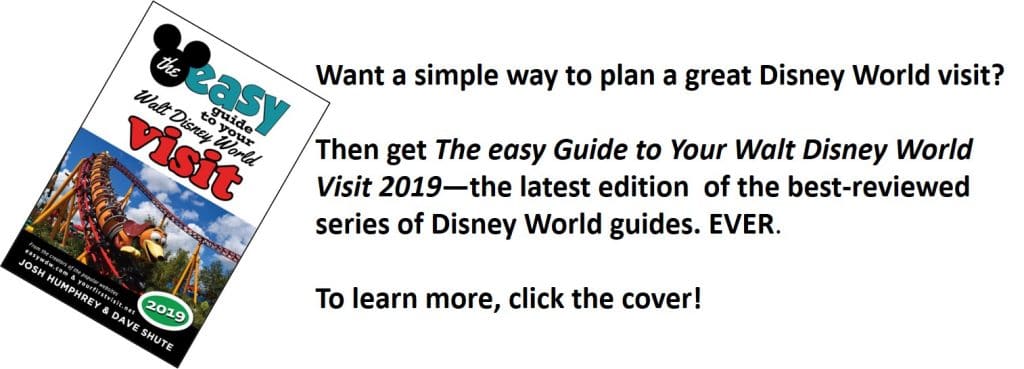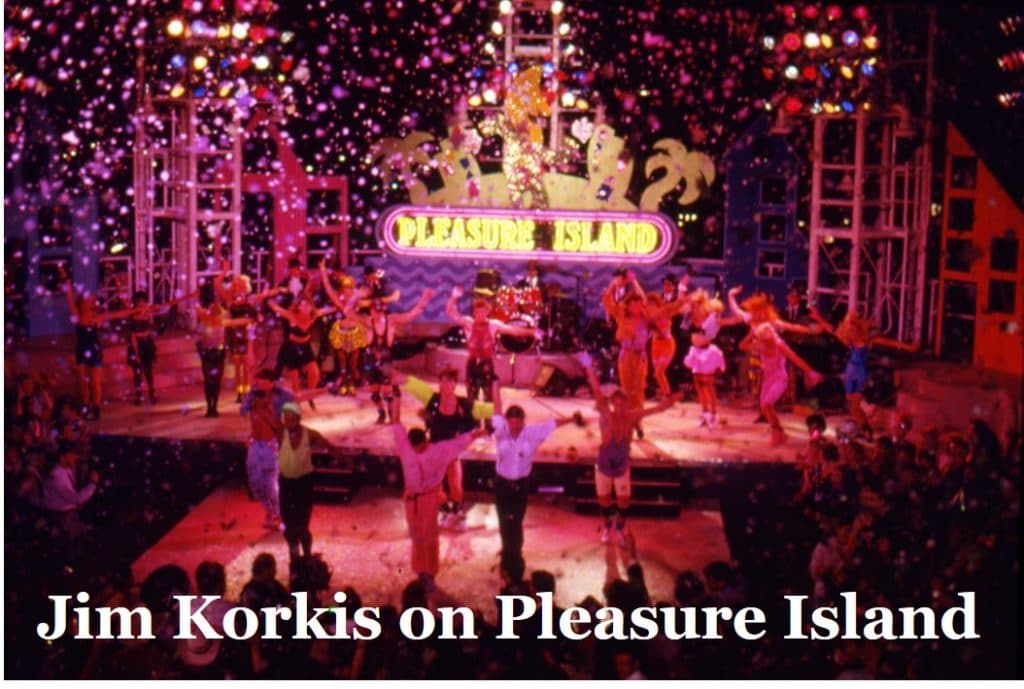Category — A Friday Visit with Jim Korkis
A Friday Visit with Jim Korkis: Walt Disney’s Imagineering Legends and the Genesis of the Disney Theme Park
Welcome back to Fridays with Jim Korkis! Jim, the dean of Disney historians, writes about Walt Disney World history every Friday on yourfirstvisit.net.
YOUR PERSONAL DISNEY LIBRARY (17)
By Jim Korkis
- Walt Disney’s Imagineering Legends and the Genesis of the Disney Theme Park by Jeff Kurtti and Bruce Gordon
While this book is a decade old, because of the material being covered in it, the information is timeless and still valuable today. It was the policy of the Disney Company that most people’s contributions to the magic remain anonymous in order to promote the Disney brand as well as the fact that many different talents may have collaborated on the final product.
When it came to the theme parks, it meant that the Imagineers were often not credited or their names might appear in an article but without any explanation of specifically what they did.
“Imagineer” is a Disney word coined by Harrison “Buzz” Price that combined the two words “imagination” and “engineer” indicating that it was equally important not just to dream up an idea but to find a way to make it a reality.
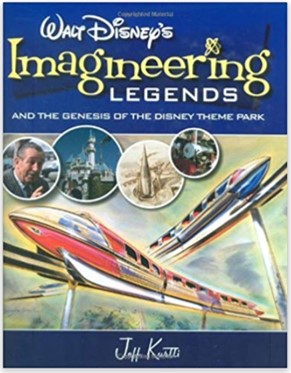
Each person receives their own chapter covering their lives and identifying their projects. Photographs show these Imagineers at work, painting, sculpting and model-making among other things. The book is filled with their color concept art usually unseen by the general public.
The newer generation of Tony Baxter, Joe Rohde, Kim Irvine, Tom Fitzgerald and others do not appear, probably because a sequel was intended but never produced.
Author Jeff Kurtti has been a leading Disney authority for decades and is still very active in Disney scholarship with several new books scheduled for release this year.
The late Bruce Gordon who is the co-author (and regrettably passed away much too young, just before this book came out) was an Imagineer for roughly a quarter of a century and not only significantly contributed to many Disney attractions like Splash Mountain but authored many important books about the many worlds of Disney.
Both of them are noted for their accuracy in their writing and because of their direct acquaintance with these people, their ability to share information and anecdotes that appear nowhere, else from Imagineering yo-yo contests in the halls to the lawyer who won the handstand walking contest.
Their stated goal was to familiarize people with the core team of creative people who worked with Walt on the theme parks and related projects and in that, they succeeded.
In the process, the book covers not only these specific individuals but the history of Imagineering and how it operated under Walt’s supervision. It can certainly be argued that some people like Mary Blair and Alice Davis have been ignored because of the restrictions of space. However, for some of the others who have been included, this is the only information on them and their lives that exists in an easily accessible resource.
For me, one of the additional joys of the book are the people sharing their personal stories of working with Walt Disney giving great insight into a man who was really a boy who never grew up. This book is recommended for a much better understanding of the people behind Disneyland and Walt Disney World.
* * * * *
Thanks, Jim! And come back next Friday for more from Jim Korkis!
In the meantime, check out his books, including his latest, The Unofficial Walt Disney World 1971 Companion: Stories of How the World Began, and Secret Stories of Walt Disney World: Things You Never You Never Knew, which reprints much material first written for this site, all published by Theme Park Press.
Follow yourfirstvisit.net on Facebook or Twitter or Pinterest!!
May 31, 2019 No Comments
A Friday Visit with Jim Korkis: President Trump in the Hall of Presidents
Welcome back to Fridays with Jim Korkis! Jim, the dean of Disney historians, writes about Walt Disney World history every Friday on yourfirstvisit.net.
TRUMP IN THE HALL OF PRESIDENTS
By Jim Korkis
Without fanfare, a new audio-animatronics figure representing President Donald J. Trump premiered quietly at the Hall of Presidents in the Magic Kingdom on Tuesday December 19, 2017. Anticipating possible problems, a Disney security guard was stationed at the back of the auditorium for a clear view of the entire audience.
There had been a petition that garnered more than 15,000 signatures “to stop the inevitable Donald Trump animatronic figure from speaking” claiming that he “ran a Presidential campaign on hateful speech, misogyny, racism and xenophobia.”
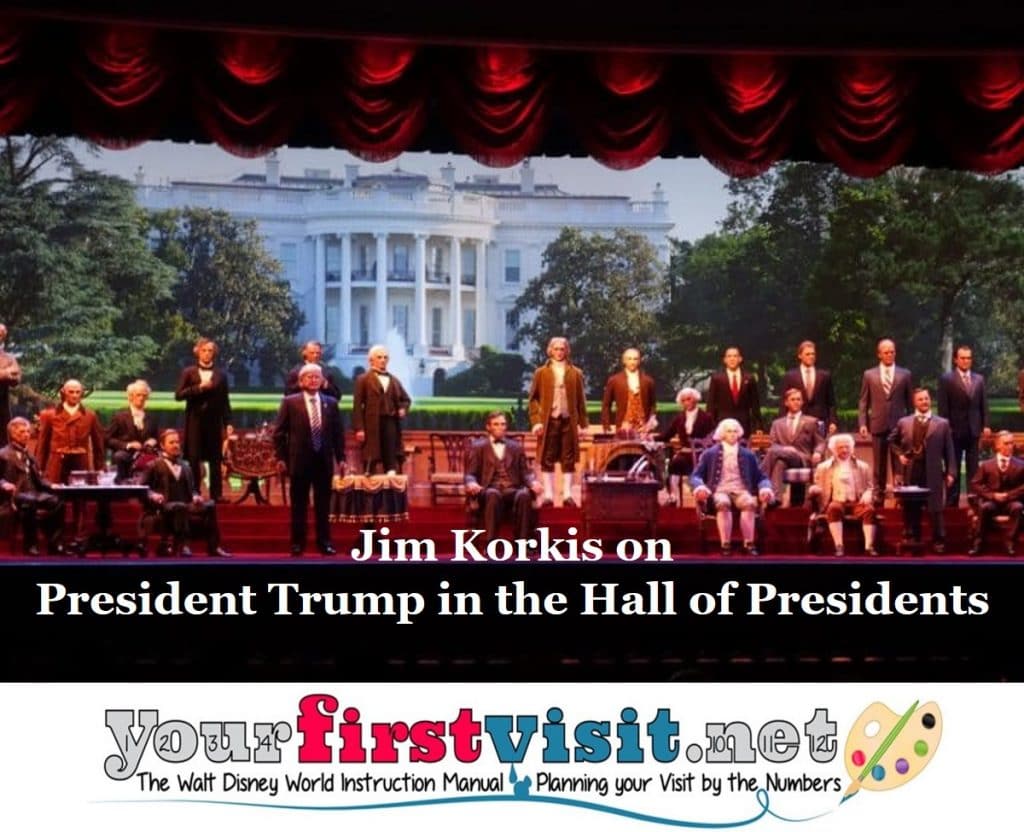
Having President Trump speak continues a tradition of having a sitting president speak that began with President Bill Clinton in 1993. Thomas Smith, editorial content director for the Disney Parks wrote, “We worked closely with the current White House just as we have with previous administrations.”
Disney CEO Bob Iger stated, “There was already a script that was written for his team to edit; we were hopeful that by the first anniversary of his election, he’ll be there with all the other presidents that preceded him but it is always a challenge.”
The President recorded his speech sometime after June 2017, which resulted in a delay in installation of the figure from its previously announced July appearance.
The Trump figure with an unbuttoned suit jacket with extra long white and blue tie stands between a seated Abraham Lincoln and Ulysses S. Grant. As with previous presidents, Imagineers requested Trump’s exact measurements and carefully studied film footage and still photos. The Trump figure moves his head during the traditional roll call of leaders, motions with his arms and gives a brief speech.
While most agreed that Disney was able to capture the hairstyle and hand gestures pretty exactly, there was controversy that the face was not completely accurate, although there is ample evidence that many of the previous presidents did not look exactly like their counterparts either.
A Disney press releases states the figure “features the latest advances in technology that enable smoother and more lifelike movements.” In addition to the new figure, when the attraction was closed it underwent an elaborate renovation, including a high definition projection system and updated sound and lighting equipment.
After George Washington speaks briefly, the audio-animatronics Trump figure recites the Oath of Office and then delivers the following speech in front of the backdrop of the White House:
“From the beginning, America has been a nation defined by its people. At our founding, it was the American people who rose up to defend our freedoms and win our independence.
“It is why our founders began our great Constitution with three very simple words: We The People.
“Since that moment, each generation of Americans has taken its place in defense of our freedom, our flag, our nation under God.
“These are the achievements of the American spirit—the spirit of a people who fought and died to bring the blessings of liberty to all our people. Above all, to be an American is to be an optimist, to believe that we can always do better and that the best days of our great nation are still ahead of us.
“It’s a privilege to serve as the president of the United States, to stand here among so many great leaders of our past, and to work on behalf of the American people.”
* * * * *
Thanks, Jim! For more on the updates to the Hall of Presidents, see this.
And come back next Friday for more from Jim Korkis!
In the meantime, check out his books, including his latest, The Unofficial Walt Disney World 1971 Companion: Stories of How the World Began, and Secret Stories of Walt Disney World: Things You Never You Never Knew, which reprints much material first written for this site, all published by Theme Park Press.
Follow yourfirstvisit.net on Facebook or Twitter or Pinterest!!
May 24, 2019 No Comments
A Friday Visit with Jim Korkis: The Magic of Walt Disney World
Welcome back to Fridays with Jim Korkis! Jim, the dean of Disney historians, writes about Walt Disney World history every Friday on yourfirstvisit.net.
THE MAGIC OF WALT DISNEY WORLD
By Jim Korkis
With the upcoming 50th Walt Disney World anniversary, Disney fans are curious about what the popular vacation destination was like when it was first opened in 1971. Thankfully, there is an opportunity to do so.
The Magic of Walt Disney World is an approximately thirty minute 1972 theatrical featurette produced by Walt Disney Productions to offer a tour of the first phase of the new Vacation Kingdom in Florida.
Inspired by the success of the forty-two minute 1956 theatrical featurette Disneyland U.S.A. that helped promote that new theme park, this similar, shorter Technicolor featurette was produced to emphasize the differences between the two parks. For instance, there are extended sections featuring the Country Bear Jamboree and the Hall of Presidents, since those attractions were unique to WDW.
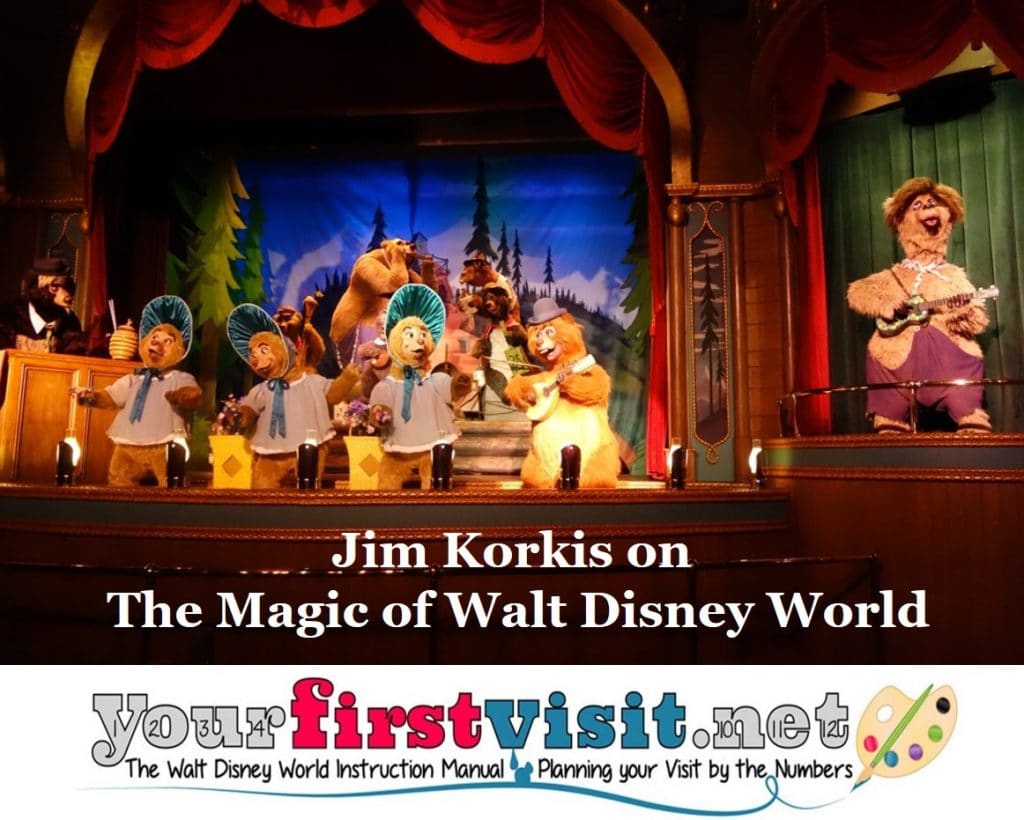
“But now, squarely in the middle of the very same bit of land, another new world has been opened up: Walt Disney World. The foundations of Walt Disney World were the dreams of one man. The sharing of those dreams with others has truly created a new world, and its reality is living proof that dreams really do come true.”
The film, which showcased not just the Magic Kingdom but also the resorts and recreational activities, premiered in theaters December 20, 1972, paired with the Disney live action film Snowball Express featuring Dean Jones. An expanded and updated version with new narration by Andrew Duggan was broadcast as an episode of The Wonderful World of Disney on March 31, 1974. Fortunately, the entire featurette is available on YouTube.
Produced by Ron Miller. Directed by Tom Leetch. Assistant Director Ronald R. Grow. Written by Tom Leetch and Bill Bosche (narration). Narrated by Steve Forrest. Music by Buddy Baker. Cinematogrpahy by John M. Stevens. Edited by Lloyd L. Richardson.
Why Forrest as narrator? Forrest had appeared in the Disney live action films Rascal (1969), The Wild Country (1971) and narrated the Disney television episodes The Owl That Didn’t Give a Hoot (1968) and Wild Geese Calling (1969). The Wild Country went into general release on January 20, 1971. The movie poster advertised that Walt Disney World would be opening that October.
Of course, today it all seems quaint from the outdated hairstyles and fashions of the guests who were enjoying the vacation kingdom to how simple and uncrowded WDW seemed. The character costumes are almost unrecognizable from the versions in the parks today. How many remember when Pooh had a jar of honey on the top of his head like a hat?
One of the charms is seeing things that have long since disappeared like the Skyway floating above the park, the 20,000 Leagues attraction with the submarines designed to mimic the one piloted by Captain Nemo in the famous live action movie, the sea serpent topiary outside of Cinderella Castle, the infamous Bob-A-Round boats in the Seven Seas Lagoon, part of the water ski show and even part of a performance at the Top of the World Lounge at the Contemporary.
Equally amazing are all the things that have remained pretty much the same over the last half century. I only wish this film had been longer, and that Disney would have done one of these every year.
* * * * *
Thanks, Jim! And if you are interested in this era of Walt Disney World, check out Jim’s latest book, The Unofficial Walt Disney World 1971 Companion: Stories of How the World Began
And come back next Friday for more from Jim Korkis!
In the meantime, check out his books, including his Secret Stories of Walt Disney World: Things You Never You Never Knew, which reprints much material first written for this site, all published by Theme Park Press.
Follow yourfirstvisit.net on Facebook or Twitter or Pinterest!!
May 17, 2019 No Comments
A Friday Visit with Jim Korkis: Pleasure Island
Welcome back to Fridays with Jim Korkis! Jim, the dean of Disney historians, writes about Walt Disney World history every Friday on yourfirstvisit.net.
REMEMBERING PLEASURE ISLAND
By Jim Korkis
This year marks the 30th anniversary of the opening of Pleasure Island in May 1989 and the 10th anniversary of its final closing in September 2008. It was a Disney nighttime entertainment venue in an area that is now part of Disney Springs.
There were two real life inspirations for Disney’s Pleasure Island. Chris Carradine, who was Vice President of Design Development for Concept and Design at Walt Disney Imagineering, was impressed with Granville Island in Vancouver, a manufacturing village that had fallen on hard times that had its buildings transformed into restaurants, theaters and shops and became a popular destination for both the residents and tourists.
The second inspiration was the Church Street Station area in downtown Orlando. By 1985, it had become the fourth most popular tourist attraction in the state of Florida, right behind Walt Disney World, Sea World and Busch Gardens.
Its colorfully themed clubs and shops were a favorite nighttime spot for both locals and tourists. Eisner felt that creating a similar entertainment venue would keep guests and their money on Disney property.
When Pleasure Island opened, there were twenty-six plaques placed at the entrances of the island and on the individual buildings by the Pleasure Island “Histerical” (sic) Society to explain the mythology of the island in elaborate detail.
Walt Disney Imagineering created a back story of a Pittsburgh entrepreneur named Merriweather Adam Pleasure who arrived with his family on a Mississippi side-wheeler that steamed into Lake Buena Vista in 1911.
He envisioned a manufacturing center, research lab and development facility, as well as a social gathering spot for the famous and well-to-do. When Pleasure and his daughter disappeared on a voyage in 1941, the island fell on hard times with Hurricane Connie in 1955 inflicting near-total destruction.
The once bustling harbor community became a ghost town. But in 1987, Disney Imagineers re-discovered the island. Some buildings were renovated, and some, like the Adventurers Club that had survived disaster, were reopened.
Those new businesses included Mannequins Dance Palace (with a large rotating floor and overhead mannequins attired in a variety of theatrical costumes), Neon Armadillo Saloon (a country and Western location inspired by the Cheyenne Saloon and Opera House at Church Street Station that Eisner visited and saw a huge line waiting anxiously to enter) XZFR Rockin’ Rollerdrome (a dance club with a skating rink on the upper floors), Videopolis East (a non-alcoholic club catering specifically to people younger than 21), the Fireworks Factory (a restaurant specializing in barbecue to match the “burnt” theme of a stray spark from Pleasure’s cigar that had set off fireworks and blackened the interior of the building), the Portobello Yacht Club (an authentic Northern Italian cuisine restaurant), Merriweather’s Market (a food court with four distinct sections where everything was cooked to order), the Comedy Warehouse and the Adventurers Club.
In addition, there were many shops unique to the location including Avigators Supply (featuring aviation and clothing merchandise with a winged alligator who was supposed to be another mascot of the Island besides the half moon-faced Funmeister), YesterEars (selling Disneyana items), Suspended Animation (selling Disney artwork) and Jessica’s of Hollywood which opened in 1990 and showcased a giant two-sided neon sign of Jessica Rabbit with sequined dress and swinging leg who sat atop the light purple colored building to entice customers inside to purchase jewelry or nightgowns that featured her logo.
Disney faced many unexpected challenges running nightclubs and changes were made almost immediately including celebrating New Year’s Eve every night. Operational issues including rowdy youth gangs resulted in the location closing in late September 2008.
“Our decision is largely based on guest feedback,” said the official Walt Disney World, “We are seeing more demand for shopping and dining experiences and less demand for clubs.”
* * * * *
Thanks, Jim! And come back next Friday for more from Jim Korkis!
In the meantime, check out his books, including his latest, The Unofficial Walt Disney World 1971 Companion: Stories of How the World Began, and his Secret Stories of Walt Disney World: Things You Never You Never Knew, which reprints much material first written for this site, all published by Theme Park Press.
Follow yourfirstvisit.net on Facebook or Twitter or Pinterest!!
May 10, 2019 No Comments
A Friday Visit with Jim Korkis: Cinderella Castle
Welcome back to Fridays with Jim Korkis! Jim, the dean of Disney historians, writes about Walt Disney World history every Friday on yourfirstvisit.net.
CINDERELLA CASTLE AT THE MAGIC KINGDOM
By Jim Korkis
Cinderella Castle quickly became the icon for Walt Disney World.
The design for it by Imagineer Herb Ryman took the form of a romanticized composite of such fabled French courts as Fontainebleau, Versailles, and a dozen famed chateaux of the Loire Valley including Chenonceau, Chambord and Chaumont since the Disney animated feature Cinderella was based on the French version of the fairy tale. Ryman was also influenced by the blue-tipped turrets of the Alcazar in Segovia in Spain and even the Tyn Church in Prague.
People have always had a fascination for castles, and a desire to explore inside them, which is why King Stefan’s Banquet Hall (now Cinderella’s Royal Table) was originally included.
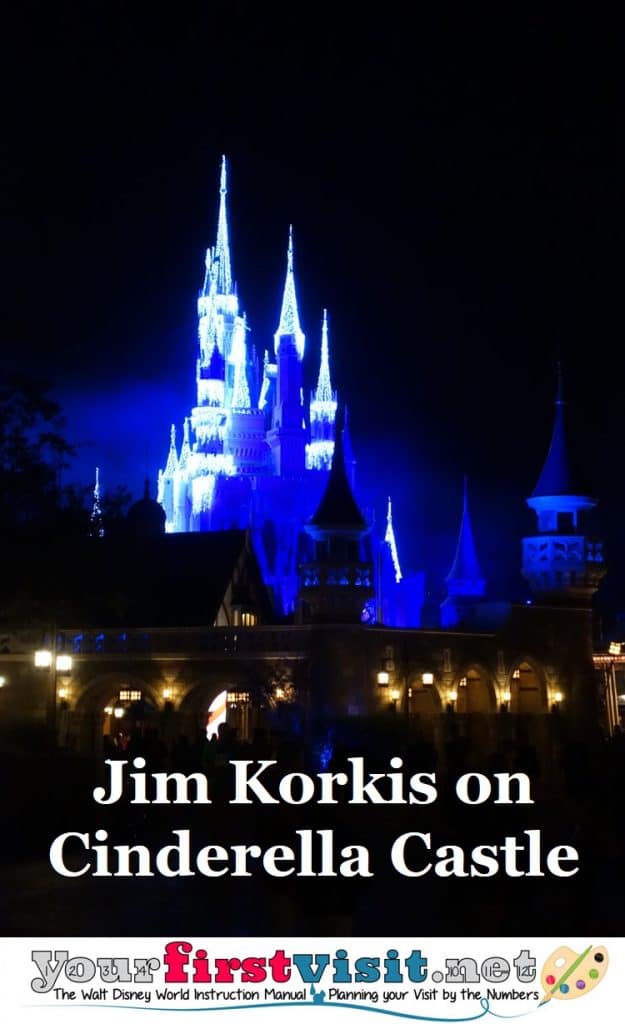
The castle is made of steel and concrete. Six hundred tons of steel make up the inner structure, which is encircled by a ten inch reinforced concrete wall. It sits on a concrete drilled caisson foundation that is 100-by-100-foot.
Most of the exterior appearance that suggests stones is a very hard fiber-reinforced gypsum plaster supported by metal studs. Fiberglass was used for the more ornate exterior walls of the upper towers. Roofs are made of the same type of plastic that computer monitor shells are made from.
Towers were raised by crane, welded and bolted permanently in place. There are 27 towers on the castle, numbered 1-29. Tower numbers 13 and 17 were deleted before construction since they could not easily be seen from anywhere in the park, primarily because of obstruction from other Fantasyland buildings.
The tower with the clock in front is number 10, the tallest is number 20, and number 23 is the other golden-roofed tower. In 2015, Disney added an additional four turrets to Cinderella Castle.
The turrets cannot be removed. It made more sense to build the castle to withstand 110 mile per hour or more hurricane force winds than to build it so that it could be quickly disassembled before a hurricane. Disassembly would have been a time and labor intensive process, not to mention reassembling it.
In 2010, dismantling the castle turrets was listed by Time magazine as one of the top five most popular urban legends about Walt Disney World. The castle has survived several hurricanes during the last nearly half century.
As a result of the September 11th attacks in 2001, amid concerns that general aviation could pose a threat to public safety, the Federal Aviation Administration placed a permanent Flight Restriction over the entire Walt Disney World Resort in Orlando, Florida.
Law enforcement and Walt Disney World aircraft are exempt from this restriction. Since the castle is smaller than two hundred feet high, it does not need to comply with the FAA regulation that would require flashing warning lights at the top.
There are two other Disney Cinderella Castles. The one at Tokyo Disneyland is also 189 feet high. The Cinderella Castle that most Disney fans forget stands proudly in the Storybook Land attraction in Disneyland.
* * * * *
Thanks, Jim! And come back next Friday for more from Jim Korkis!
In the meantime, check out his books, including his latest, The Vault of Walt Volume 7: Christmas Edition, and his Secret Stories of Walt Disney World: Things You Never You Never Knew, which reprints much material first written for this site, all published by Theme Park Press.
Follow yourfirstvisit.net on Facebook or Twitter or Pinterest!!
May 3, 2019 No Comments
A Friday Visit with Jim Korkis: Disney’s Animal Kingdom is “Nahtazu”
Welcome back to Fridays with Jim Korkis! Jim, the dean of Disney historians, writes about Walt Disney World history every Friday on yourfirstvisit.net.
THE ANIMAL KINGDOM IS NOT A ZOO
Back in 2002, to try to get the general public to understand that Disney’s Animal Kingdom was not like the typical zoo a person might visit, but rather a new type of theme park, in 2002 WDW through its Yellow Shoes Creative Marketing division brought on Mark Simon to storyboard a thirty-second commercial spot.
The final commercial was produced by Jim Derusha of Alpha Wolf Productions and consisted of various DAK cast members declaring “Nahtazu”, a fictional word that when pronounced sounded like “not a zoo”.
The commercial ended with the tag line: “Disney’s Animal Kingdom. It’s many, many things but remember, it’s Nahtazu!”
Disney stopped using the term in 2006 as it strengthened its connections with the AZA (Association of Zoos and Aquariums).
The idea of it not being a zoo came from Imagineer Joe Rohde, executive designer and senior vice president, Creative for Walt Disney Imagineering. In a presentation to DAK cast members on June 14, 1998, roughly a week before the park opened to the public, he stated:
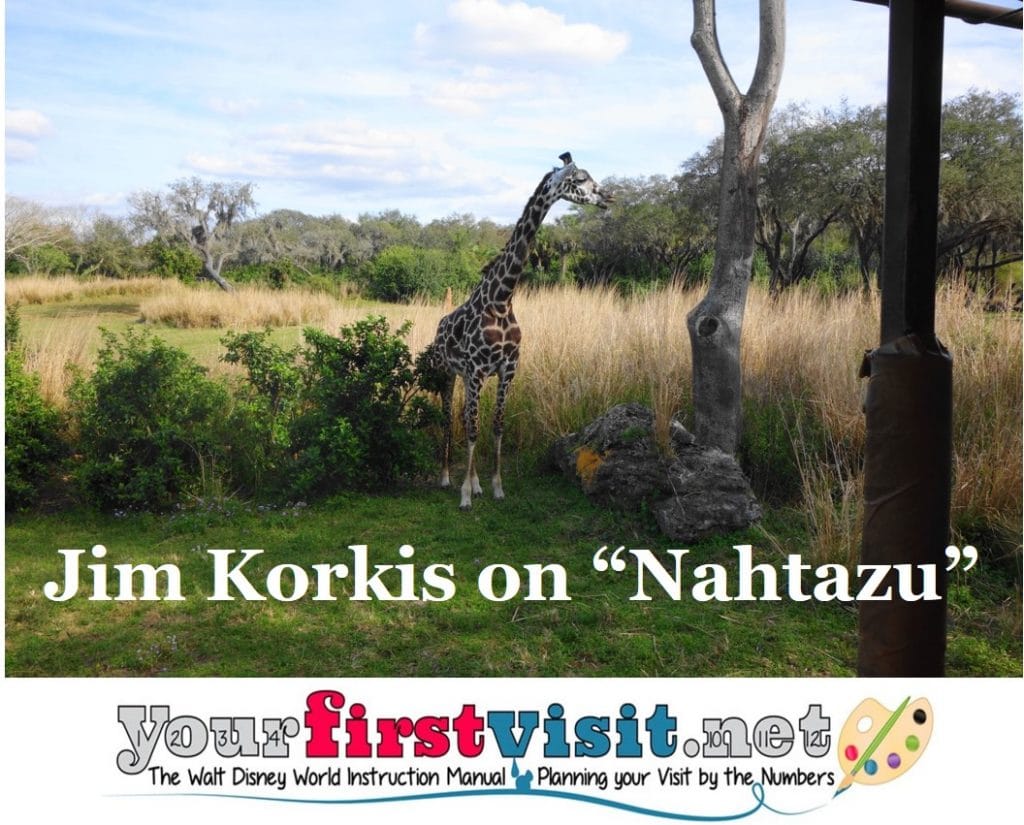
“We the Disney Company simply cannot do what is out there to be done if for no other reason than we’re gonna charge you $50 or more to do it. So it has to be different, it has to be new, it has to be unlike anything else you can do or we simply cannot pursue it as a line of business because we can’t make our per cap.
“There’s still people in the company who will refer to this as a ‘zoo’ and I mean, by no means, any disrespect or disdain to what a zoo is. [A zoo] is a thing that exists in the world and is loved and valued, obviously, by their presence around the country and the world, by gazillions of people.
“It serves a purpose, it occupies a niche and it does it really rather well. That’s the point. That job’s done. The world doesn’t need another big, expensive zoo with a bunch of immersion exhibits in it. That is not a real pressing need on the planet.
“A zoo sits in a category of places within a community that is sort of comparable to the museum, to the library, in that it’s regarded with a kind of respectful awe. It represents a scientific stance. It is a place you go for a kind of edification. There’s always a secondary use of a zoo as a garden, as a place to just go stroll with kids in the sunlight when the weather is good. There’s clearly a recognition that this is a place of edification.
“Now, on the other hand, what we are trying to do is profoundly subjective, even in ways that I think many education professionals would consider to be almost dangerous. A theme park is all about you in a very specific context. Nothing happens to you…nothing is said to you…nothing is seen by you…that isn’t governed by the overarching narrative umbrella that holds you in that place. When you move through a space, the space is crafted to specific narrative impact on you. That’s what Disney’s Animal Kingdom is. It is not a zoo.”
* * * * *
Thanks, Jim! And come back next Friday for more from Jim Korkis!
In the meantime, check out his books, including his latest, The Vault of Walt Volume 7: Christmas Edition, and his Secret Stories of Walt Disney World: Things You Never You Never Knew, which reprints much material first written for this site, all published by Theme Park Press.
Follow yourfirstvisit.net on Facebook or Twitter or Pinterest!!
April 26, 2019 No Comments


